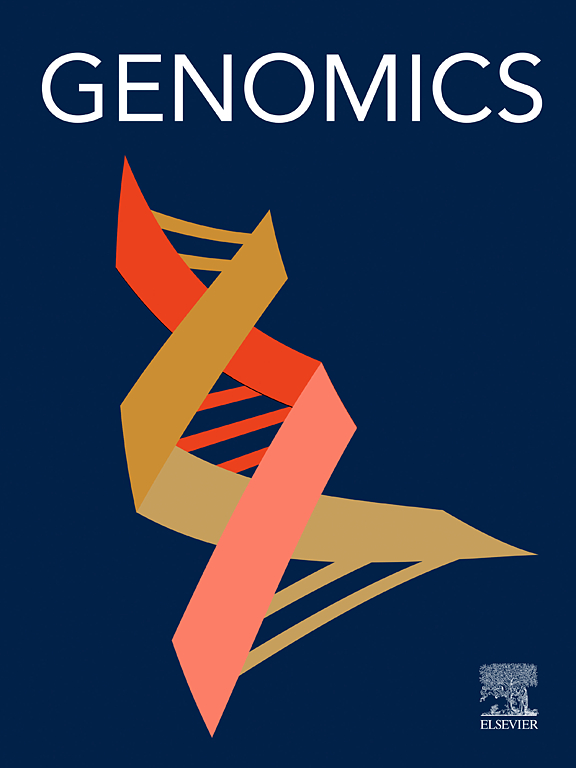综合基因组学和转录组学分析确定了影响猪胴体背膘厚度的新的候选基因。
IF 3
2区 生物学
Q2 BIOTECHNOLOGY & APPLIED MICROBIOLOGY
引用次数: 0
摘要
胴体背膘厚度(BFT)是脂肪沉积和胴体瘦度的重要指标,对胴体分级和定价具有重要意义。利用综合多组学方法鉴定与BFT相关的遗传位点和关键基因对猪的遗传进步有重要贡献。本研究屠宰了418头中国苏淮猪,随后测定了胴体肥厚。我们分别基于SNP芯片数据和全基因组测序数据进行了全基因组关联研究(GWAS)。结果表明,与胴体肥力相关的显著数量性状位点(QTL)分布在猪的SSC 2、SSC4和SSC14染色体上,其中最显著的单核苷酸多态性(snp)解释了6.58 % ~ 9.91 %的表型变异。贝叶斯精细定位验证了两个先前报道的数量性状位点(qtl),将最精细的置信区间缩小到3 kb (SSC2, 37.337-37.340 Mb和SSC4, 75.407-77.006 Mb),同时鉴定出两个与胴体BFT相关的新qtl (SSC14, 137.086-138.863 Mb和SSC4, 95.237-96.894 Mb)。此外,转录组分析确定了322个差异表达基因(DEGs)和一些与脂质和能量代谢相关的关键调控途径,包括脂肪酸和丙酮酸代谢。整合基因组和转录组学数据确定了三个关键的候选基因:S100A12、XKR4和PENK,它们通常与BFT相关。转录组全关联研究(TWAS)和表型全关联研究(PheWAS)进一步证明这三个基因与BFT和脂肪酸组成显著相关。本研究对猪胴体肥厚相关的重要基因和分子标记有了新的认识。本文章由计算机程序翻译,如有差异,请以英文原文为准。
Integrated genomic and transcriptomic analysis identifies novel candidate genes affecting carcass backfat thickness in pigs
The carcass backfat thickness (BFT) provides a valuable indication of fat deposition and carcass leanness, which are essential for the determination of carcass grading and pricing. Identifying genetic loci and crucial genes related to BFT using integrated multi-omics methods offers significant contributions to the genetic advancement of pig. In the present study, 418 Chinese Suhuai pigs were slaughtered, and carcass BFT were subsequently measure. We conducted a genome-wide association study (GWAS) based on SNP chip data and imputed whole-genome sequencing data (iWGS), respectively. Significant quantitative trait loci (QTL) correlated with carcass BFT were identified on Sus scrofa chromosome (SSC) 2, SSC4, and SSC14, with the most significant single-nucleotide polymorphisms (SNPs) explaining 6.58 %–9.91 % of the phenotypic variance. Bayesian fine mapping validated two previously reported quantitative trait loci (QTLs), narrowing the most refined confidence interval to 3 kb (SSC2, 37.337–37.340 Mb and SSC4, 75.407–77.006 Mb), while identifying two novel QTLs (SSC14, 137.086–138.863 Mb and SSC4, 95.237–96.894 Mb) associated with carcass BFT. Furthermore, transcriptome analysis identified 322 differentially expressed genes (DEGs) and several critical regulatory pathways related to lipid and energy metabolism, including fatty acid and pyruvate metabolism. The integration of genomic and transcriptomic data identified three pivotal candidate genes, S100A12, XKR4 and PENK, which are typically associated with BFT. Transcriptome-wide association study (TWAS) and Phenome-wide association study (PheWAS) provided further evidence that these three genes were significantly associated with BFT and fatty acid composition. This study uncovers novel insights into the important genes and molecular markers related to carcass BFT in pig.
求助全文
通过发布文献求助,成功后即可免费获取论文全文。
去求助
来源期刊

Genomics
生物-生物工程与应用微生物
CiteScore
9.60
自引率
2.30%
发文量
260
审稿时长
60 days
期刊介绍:
Genomics is a forum for describing the development of genome-scale technologies and their application to all areas of biological investigation.
As a journal that has evolved with the field that carries its name, Genomics focuses on the development and application of cutting-edge methods, addressing fundamental questions with potential interest to a wide audience. Our aim is to publish the highest quality research and to provide authors with rapid, fair and accurate review and publication of manuscripts falling within our scope.
 求助内容:
求助内容: 应助结果提醒方式:
应助结果提醒方式:


